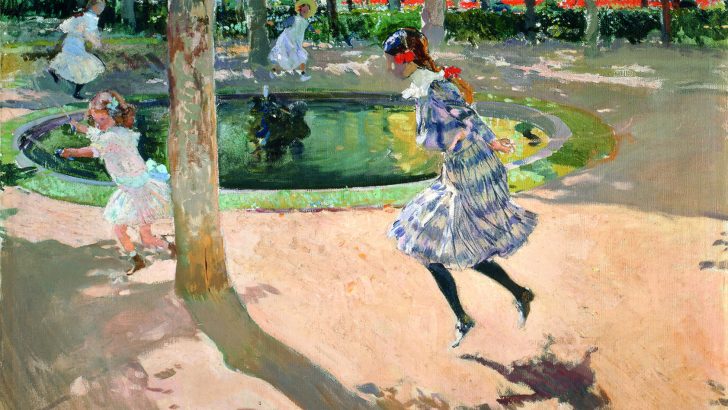Sorolla: Spanish Master of Light, an exhibition
Beit Wing (Rooms 6-10), National Gallery of Ireland, Merrion Square Dublin 2
Sorolla: Spanish Master of Light
by Gabriele Finaldi and others, published to accompany the exhibition (National Gallery Company London /distributed by Yale University Press, £30.00/€35.00)
This exhibition is the first ever mounted in Ireland, so though the artist Joaquín (1863-1923) may be known by name, his impressionist work will be unfamiliar to many.
This is very much “a-must-see” exhibition. His images are filled with joie de vivre, with life lived under the bright hard sun of Spain, largely in his native Valencia.
Sorolla was indefatigable: there are photographs in the book that accompanies the exhibition of him at work on the beach en plein air, well shaded himself but working hard to capture with rapid ease the effects of light around him; one shows him painting ‘Snapshot’, a painting on exhibition here.
Bright light
But that bright light also made for shade: Jumping Rope shows both broad sunlight and tree lined shade in a park where children are playing, their delight skilfully registered in the paint.
The dappled effect of light filtered through the sheltering vines over terraces or in gardens is caught with extraordinary flair. And bright sun means darkness too: another painting of a Basque tavern is crowded with men plying an alcoholic with cider, who leers blearily at the artist.
This exhibition covers the whole range of Sorolla’s achievements as a painter, from commissioned portraits to highly evocative ethnographic images of provincial men and women in feast-day costumes.
Sorolla lived through the turn of the 20th Century. This was a time when the loss of Cuba and the Philippines in 1898 to the rising American empire demoralised the ruling elite, proving a prelude to the political changes that eventually overthrew the monarchy, a revolution which was in itself a prelude to the Civil War.
Sorolla, however, was a conservative, a family man he was comfortable in settled tradition. He respected religion, for instance, there are two paintings here, ‘Kissing the Relic’ and an image of a St John of God brother overseeing a bathing party of crippled boys (a reminder of the country endemic poverty), showing his own sense of reverence for faith and respect for the charity of the Church.
But on the whole this is an exhibition that delights in life and nature, especially the sea.
The book which accompanies the exhibition is the work of a group of Spanish Sorolla experts and is intended to explore the backgrounds to the pictures on display through a series of essays on Sorolla’s life and work and times.
It illustrates many images which are not on display here. It provides an impressive introduction to those unfamiliar with his work by a man who in his lifetime was called ‘the world’s greatest living painter’. That might seem an extravagant title to live up to, but leaving the exhibition a visitor might well believe that Sorolla is certainly one of those who might be named in that exclusive group.
This is a show to see, not once but several times, for there are aspects to the pictures which will take time to fully appreciate, but the exhibition lasts long enough to do just that.
The exhibition, curated by Dr Brendan Rooney, Head Curator, and Dr Aoife Brady, Curator of Italian and Spanish Art, National Gallery of Ireland, runs until 3 November 2019; tickets €15/ retired €10/ student €5.


 Peter Costello
Peter Costello Jumping Rope, La Granja (Saltando a la comba, La Granja), 1907; Joaquín
Sorolla y Bastida (1863-
1923); No. inv. 00797,
Museo Sorolla. From the exhibition ‘Sorolla: Spanish Master of Light’, August 10 – November 3, 2019,
National Gallery of Ireland.
Jumping Rope, La Granja (Saltando a la comba, La Granja), 1907; Joaquín
Sorolla y Bastida (1863-
1923); No. inv. 00797,
Museo Sorolla. From the exhibition ‘Sorolla: Spanish Master of Light’, August 10 – November 3, 2019,
National Gallery of Ireland. 